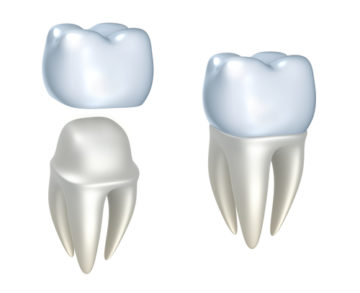Dental crowns are much stronger and more permanent than fillings. They are normally fitted to repair broken teeth or teeth weakened by decay or a large filling. Crowns can improve the appearance of a tooth or even hold a bridge or denture in place.
Ultimately, a crown is a protective cover that fits over a broken or decayed tooth, which is why a crown can be called a cap. It can be made of porcelain bonded to precious metal (looks very natural so this is good for front teeth), ceramic (a metal free alternative), glass or gold-alloy (very hard wearing).
The dentist will discuss the options available and advise if they think a crown is the best solution. If you do decide to go ahead, you will require at least two appointments. The first to prepare the tooth for the crown, create an impression and cover the tooth with provisional restoration. The second for cementation of the permanent crown. If you are having a crown fitted to your front teeth you may require more than two visits, to ensure an exact cosmetic fit.
If you’re curious, we have answers to the most common questions below. If you still have a burning question, don’t hesitate to contact us to ask!
Crowns repair broken teeth and make them strong again. You may also have a crown if you've had root canal therapy and need to protect what is left of the tooth. Sometimes crowns are required to hold a bridge or a denture in place.
You will need to have at least two visits. In the first visit, we prepare the tooth, take impressions and record the shade of the tooth. We then fit the temporary crown. In the second visit, we fit the permanent crown. There will usually be about 1 to 2 weeks between appointments.
It shouldn't hurt. You can have a local anaesthetic and the preparation work should feel no different from a filling. If the tooth does not have a nerve, you may not need a local anaesthetic.
The crown will be made to match your other teeth as closely as possible.
The shape will be slightly different from the shape of your tooth before it was crowned, but within a few days you will not notice the difference. If your bite does not feel comfortable, come back and ask us to check and adjust it.
Crowns can be made of a variety of different materials. Some of the most options are listed below.
Porcelain bonded to precious metal: this is what most crowns are made from. A precious metal base is made and then porcelain is applied in layers over it.
Porcelain: these crowns are made completely from porcelain and are not as strong as bonded crowns. But they can look very natural and are most often used for front teeth.
All-ceramic: this modern technique offers a metal-free alternative, which can give the strength of a bonded crown and the appearance of a porcelain crown. Therefore it is suitable for use in all areas of the mouth.
Glass: these crowns look very natural and can be used anywhere in the mouth.
Gold-alloy crowns: gold is one of the oldest filling materials. Today it is used with other metal alloys to increase its strength, which makes it very hardwearing. These crowns are silver or gold in colour.




